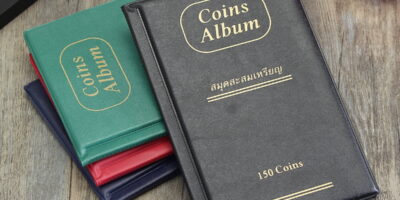The 1909 Penny: A Collector’s Perspective
The 1909 penny marks an important year for coin enthusiasts. As the last year of the Indian Head cent and the first year of the Lincoln cent, it’s a numismatic gem. Coins from this year draw intense interest from collectors and historians alike. The significance of the transition means values can vary greatly, depending on specifics.
Types of 1909 Pennies
Two major types were minted in 1909: the Indian Head cent and the Lincoln Wheat cent. Both have unique characteristics and separate valuation criteria. Understanding the differences is key to assessing their value in today’s market.
Indian Head Cent
The Indian Head cent minted in 1909 was the final run for this design. It was produced in two locations: Philadelphia and San Francisco. The Philadelphia mint, denoted with no mint mark, released 14,368,470 coins. The San Francisco mint, marked with an ‘S’, released significantly fewer, only 309,000.
This disparity affects the collectibility and value. Many collectors prize the ‘S’ version for its rarity. In good condition, an Indian Head cent from Philadelphia may fetch from a few dollars to a few hundred, depending on its state. But an Indian Head penny with the ‘S’ mint mark can soar to several thousand, particularly in higher grades.
Lincoln Wheat Cent
The Lincoln Wheat cent debuted in 1909 with much fanfare. Designed by Victor David Brenner, this coin features the famous image of President Abraham Lincoln. It came in two main varieties: with the designer’s initials, ‘V.D.B.’, on the reverse, and without.
Initials or no, this was a significant change after fifty years of the Indian Head design. In Philadelphia, production yielded 27,995,000 pieces without the ‘V.D.B.’ mark. A smaller number, 484,000, displayed the initials. The San Francisco mint produced 1,825,000 without and just 484,000 with the initials.
- Lincoln Cent without V.D.B. – Common and affordable, varying with quality.
- Lincoln Cent with V.D.B. – Highly coveted, especially the ‘S’ version.
The value fluctuates based on mint, condition, and variety. A Philadelphia V.D.B. cent in pristine condition may range up to several hundred dollars. By contrast, an ‘S’ V.D.B. can command prices well into the thousands, given its limited quantity and high demand.
Determining Value
Valuing a 1909 penny involves several factors: condition, rarity, and market demand. Professional grading can provide clarity. The Sheldon Scale is the standard for grading, running from 1 (poor) to 70 (perfect).
Higher-grade coins always fetch better prices. Even the tiniest difference in grade can mean a substantial leap in value. Collectors prioritize the quality of the coin when considering a purchase.
Aesthetic and historical appeal also play roles. Coins with clear details and minimal wear are preferred. Those in mint state or with special provenance can attract significant premiums.
The Influence of Historical Context
The year 1909 was pivotal beyond just coinage. Economically and culturally, the U.S. was changing. Industrialization and progressivism influenced designs and choices at the U.S. Mint. The shift from the Indian Head to Lincoln reflected societal transformations.
Abraham Lincoln symbolized unity and progress. Amid racial tensions and reform movements, his image was a powerful message. Coinage was one platform where such cultural narratives found expression.
Economic Fluctuations
1909 saw economic shifts impacting coin circulation and value. The economy was expanding post-recession, with industrial growth shaping commodity and product demands. Coins produced this year needed mass and versatility in a transitioning economy.
These factors can affect current values, as economic history often colors collectors’ perceptions. The story behind a coin sometimes influences its desirability and price.
Collector Communities and Market Trends
Coin collecting has grown with technological advancements. Online platforms and auctions allow collectors to connect globally. Researching market trends becomes easier, informing both purchase and sale decisions.
Enthusiast forums and societies provide rich resources for aficionados. Shared knowledge enhances understanding of historical context and valuation nuances. Social media and dedicated websites offer spaces for exchanging insights.
Trends indicate a steady or rising interest in early 20th-century U.S. coinage. Coins like the 1909 penny, with their dual historical and aesthetic appeal, tend to enjoy sustained demand.
Preservation and Condition
Preservation plays a crucial role in value. Proper storage prevents wear and environmental damage. Humidity, temperature, and even handling can affect a coin’s state.
Collectors often use tools like coin holders, albums, and specialized storage boxes. These protect from contaminants and physical contact. Cleaning coins is widely discouraged, as it can reduce value. Unaltered, naturally-patinated coins often command higher prices.
Professional Grading Services
Grading by recognized services like PCGS or NGC adds authenticity and standardization. These services employ experts to assess features and assign grades, often increasing desirability and market value.
Certified coins can simplify transactions. Buyers and sellers have a mutual understanding of quality, informed by a trusted third party. This assurance often reflects in market prices.
The Future of 1909 Pennies
As collectibles, 1909 pennies stand poised to appreciate. Their historic significance underpins a robust market presence. Prospective collectors should pay heed to quality, provenance, and market conditions.
The balance of scarcity, condition, and demand will continue to dictate value. For new and seasoned collectors, understanding these fundamentals enriches both the hobby and the market.

